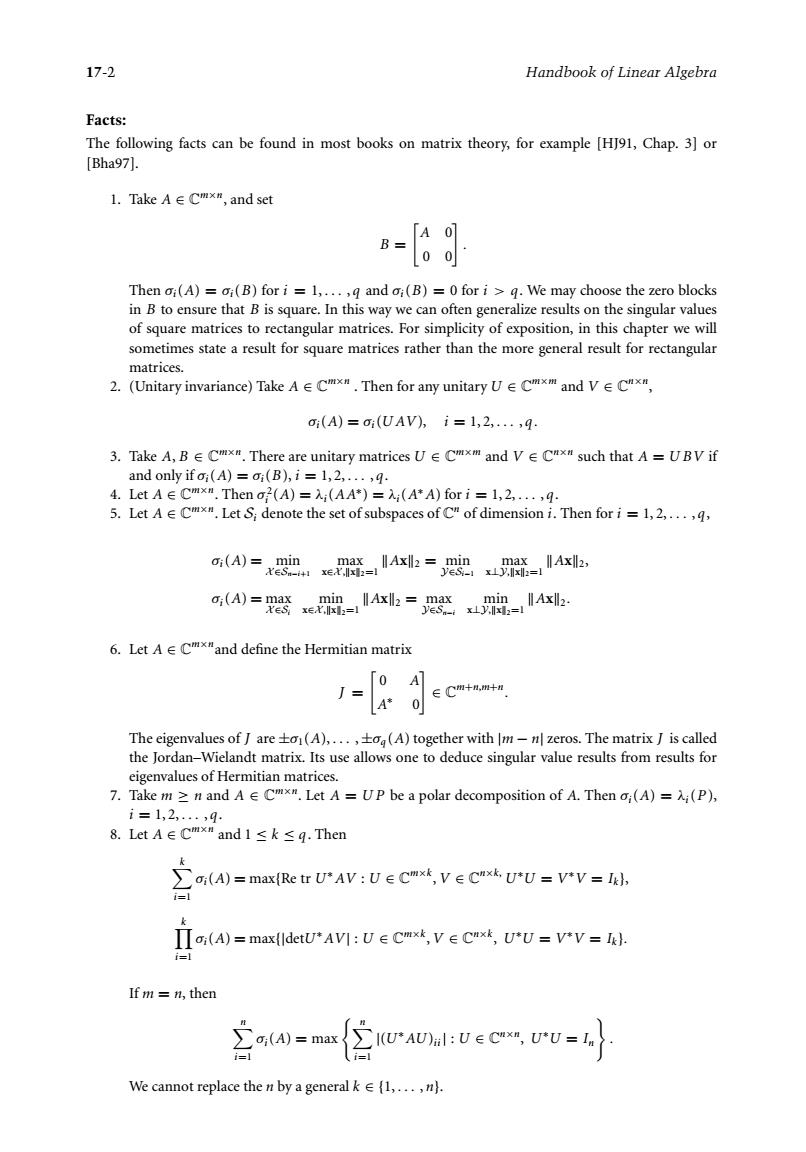正在加载图片...

17-2 Handbook of Linear Algebra Facts: The following facts can be found in most books on matrix theory,for example [HJ91,Chap.3]or [Bha97八. L.TakeA∈Cmm,and set -6d Then ;(A)=o;(B)for i =1....,q and o;(B)=0 for i>q.We may choose the zero blocks in B to ensure that B is square.In this way we can often generalize results on the singular values of square matrices to rectangular matrices.For simplicity of exposition,in this chapter we will sometimes state a result for square matrices rather than the more general result for rectangular matrices. 2.(Unitary invariance)Take ACx.Then for any unitaryUCx and VECx", (A)=(UAV),i=1,2,,9 3.Take A,BCx.There are unitary matricesUCm and VCx such that A=UBV if and only if a(A)=a(B),i=1,2.....q. 4.LetA∈g 5.Letde cex"Then df (or.. Let Sdenote the set of subspaces ofC"of dimension i.Then fori=... o(A)=eA=盟IA, A=惑照-A=殿照-A, 6.Let ACx"and define the Hermitian matrix -[ee :6 of1arc主o(以.,o,(togcthe ith-川zaos.The matri1sca n- matrix.Its use allows one to deduce singular value results from results for 7t人=UPeof九Then g,(A)=Ag crAV:U∈Cmx,V∈CmxU Πa,(A)=max[ldetU*AV:U∈Cmxk,V∈Cxk,U*U=V*V=k. If m=n,then 立W=mr{AU)l:,UU= We cannot replace the n by a generalk17-2 Handbook of Linear Algebra Facts: The following facts can be found in most books on matrix theory, for example [HJ91, Chap. 3] or [Bha97]. 1. Take A ∈ Cm×n, and set B = A 0 0 0 . Then σi(A) = σi(B) for i = 1, ... , q and σi(B) = 0 for i > q. We may choose the zero blocks in B to ensure that B is square. In this way we can often generalize results on the singular values of square matrices to rectangular matrices. For simplicity of exposition, in this chapter we will sometimes state a result for square matrices rather than the more general result for rectangular matrices. 2. (Unitary invariance) Take A ∈ Cm×n . Then for any unitary U ∈ Cm×m and V ∈ Cn×n, σi(A) = σi(U AV), i = 1, 2, ... , q. 3. Take A, B ∈ Cm×n. There are unitary matrices U ∈ Cm×m and V ∈ Cn×n such that A = UBV if and only if σi(A) = σi(B), i = 1, 2, ... , q. 4. Let A ∈ Cm×n. Then σ2 i (A) = λi(AA∗) = λi(A∗A) for i = 1, 2, ... , q. 5. Let A ∈ Cm×n. Let Si denote the set of subspaces of Cn of dimension i. Then for i = 1, 2, ... , q, σi(A) = min X ∈Sn−i+1 max x∈X ,x2=1 Ax2 = min Y∈Si−1 max x⊥Y,x2=1 Ax2, σi(A) = max X ∈Si min x∈X ,x2=1 Ax2 = max Y∈Sn−i min x⊥Y,x2=1 Ax2. 6. Let A ∈ Cm×nand define the Hermitian matrix J = 0 A A∗ 0 ∈ Cm+n,m+n. The eigenvalues of J are ±σ1(A), ... , ±σq (A) together with |m − n| zeros. The matrix J is called the Jordan–Wielandt matrix. Its use allows one to deduce singular value results from results for eigenvalues of Hermitian matrices. 7. Take m ≥ n and A ∈ Cm×n. Let A = U P be a polar decomposition of A. Then σi(A) = λi(P ), i = 1, 2, ... , q. 8. Let A ∈ Cm×n and 1 ≤ k ≤ q. Then k i=1 σi(A) = max{Re tr U∗AV : U ∈ Cm×k , V ∈ Cn×k, U∗ U = V∗V = Ik }, k i=1 σi(A) = max{|detU∗AV| : U ∈ Cm×k , V ∈ Cn×k , U∗ U = V∗V = Ik }. If m = n, then n i=1 σi(A) = max n i=1 |(U∗AU)ii| : U ∈ Cn×n, U∗ U = In . We cannot replace the n by a general k ∈ {1, ... , n}.�����